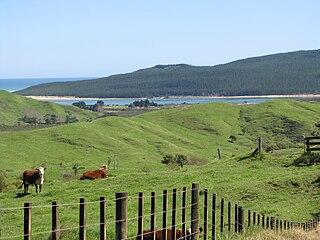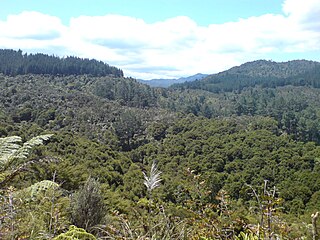Related Research Articles
Iwi are the largest social units in New Zealand Māori society. In Māori, iwi roughly means 'people' or 'nation', and is often translated as "tribe", or "a confederation of tribes". The word is both singular and plural in the Māori language, and is typically pluralised as such in English.

Ngāti Whātua is a Māori iwi (tribe) of the lower Northland Peninsula of New Zealand's North Island. It comprises a confederation of four hapū (subtribes) interconnected both by ancestry and by association over time: Te Uri-o-Hau, Te Roroa, Te Taoū, and Ngāti Whātua-o-Ōrākei. The four hapū can act together or separately as independent tribes.

Dame Whina Cooper was a New Zealand kuia, who worked for many years for the rights of her people, and particularly to improve the lot of Māori women. She is remembered for leading the 1975 Māori land march from Te Hāpua to Wellington, a distance of 1,100 km (680 mi), at the age of 79.

Ngāi Tai ki Tāmaki is a Māori tribe that is based in the area around Clevedon, part of the Auckland region. It is one of the twelve members of the Hauraki Collective of tribes.

Ngāti Awa is a Māori iwi (tribe) centred in the eastern Bay of Plenty Region of New Zealand. It is made of 22 hapū (subtribes), with 15,258 people claiming affiliation to the iwi in 2006. The Ngāti Awa people are primarily located in towns on the Rangitaiki Plain, including Whakatāne, Kawerau, Edgecumbe, Te Teko and Matatā. Two urban hapū also exist in Auckland and Wellington.
Ngāti Raukawa is a Māori iwi with traditional bases in the Waikato, Taupō and Manawatu/Horowhenua regions of New Zealand. In 2006, 29,418 Māori registered their affiliation with Ngāti Raukawa.
Ngāti Hauiti is a Māori iwi of New Zealand. It is centred in the Rangitikei area of the lower North Island.

Ngāti Whanaunga is a Māori iwi (tribe) of the Coromandel Peninsula in New Zealand, descended from Whanaunga, the third son of Marutūāhu.
Rongowhakaata is a Māori iwi of the Gisborne region of New Zealand.
Whanganui Māori are the Māori iwi (tribes) and hapū (sub-tribes) of the Whanganui River area of New Zealand. They are also known as Ngāti Hau.

Te Rarawa is a Māori iwi of Northland, New Zealand. The iwi is one of five Muriwhenua iwi of the far north of the North Island.

Rangitāne is a Māori iwi (tribe). Their rohe (territory) is in the Manawatū, Horowhenua, Wairarapa and Marlborough areas of New Zealand.
Riwia Brown is a New Zealand playwright. She is the screenwriter of the popular and award-winning New Zealand movie Once Were Warriors (1994). The Once Were Warriors screenplay, adapted from the book of the same name by Alan Duff, gained Brown the Best Screenplay award at the 1994 New Zealand Film and TV Awards. Brown has written for theatre, television and films.

Dame Iritana Te Rangi Tāwhiwhirangi is a New Zealand advocate of Māori language education and the Kōhanga Reo movement.

Sir Hepi Hoani Te Heuheu Tūkino VII was the seventh elected chief of the Ngāti Tūwharetoa iwi, a Māori tribe of the central North Island, and an influential figure among Māori people throughout New Zealand.

Te Whakaruruhau o Ngā Reo Irirangi Māori is a New Zealand radio network consisting of radio stations that serve the country's indigenous Māori population. Most stations receive contestable government funding from Te Māngai Pāho, the Māori Broadcast Funding Agency, to operate on behalf of affiliated iwi (tribes) or hapū (sub-tribes). Under their funding agreement, the stations must produce programmes in the Māori language, and must actively promote Māori culture.
Te Patukirikiri is a Māori iwi of the Hauraki area of New Zealand.

Ngāti Rongoū is a Māori iwi (tribe) of the Coromandel Peninsula in New Zealand.
Kinohaku was a Māori woman of the Ngāti Maniapoto tribe in New Zealand's Waikato region. She lived in the seventeenth century and is the eponymous ancestor of the Ngāti Kinohaku sub-tribe (hapū) of Ngāti Maniapoto.

Tara Te Irirangi (1780s–1852) also known as Te Tara ki Moehau or Ōtara Te Irirangi, was paramount chief of Ngāi Tai ki Tāmaki or Ngāti Tai, a Māori tribe of the eastern Auckland region of New Zealand, encompassing parts of the Hauraki Gulf and Wairoa Valley, as well as Ōtara, Clevedon, Maraetai and Howick. Te Irirangi was the great-grandson of Te Wana, a leading rangatira and well-known warrior of Ngāi Tai, who, during his life, strengthened Ngāi Tai control over the Maraetai-Wairoa area. Tara Te Irirangi died in 1852, after falling ill, and passed away at the mouth of the Wairoa River. He was interred in his waka in the Ngāi Tai burial swamps within the west bank of the river.
References
- 1 2 McCollum, Maureen; McCollum, Robert, Rachael Ngeungeu Te Irirangi Zister. "December 2011". Dictionary of New Zealand Biography . Ministry for Culture and Heritage.
{{cite web}}: CS1 maint: multiple names: authors list (link) - ↑ "No. 51580". The London Gazette (3rd supplement). 31 December 1988. p. 34.